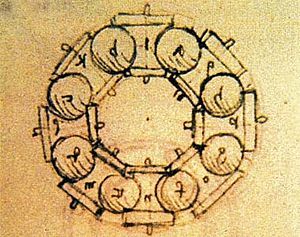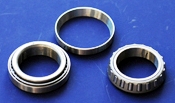Bearing (mechanical) facts for kids
Imagine two parts of a machine that need to move smoothly against each other, like a wheel spinning on an axle. A bearing is a special device that helps them do just that! It allows one part to move, often by spinning or sliding, while the other part stays still or moves differently. Bearings make sure machines work efficiently by reducing friction, which is the force that slows things down when surfaces rub together. The most common types you'll find are plain bearings, roller bearings, and ball bearings.
Contents
History of Bearings

People have used simple bearings for a very long time, even before the invention of the wheel! Early forms involved using wooden rollers to help move heavy objects. This idea of using rollers to support something being moved is very old.
Some people think the ancient Egyptians used roller bearings when moving huge stone blocks. However, their own drawings show them using sleds with wet runners, which worked more like a "plain bearing" by sliding on a slippery surface. They also used simple bearings with their hand drills.
The oldest actual rolling-element bearing found was a wooden ball bearing. It was part of a rotating table from a Roman ship that sank in Lake Nemi, Italy, around 40 BC.
Later, the famous inventor Leonardo da Vinci drew designs for ball bearings in his plans for a helicopter around the year 1500. This was the first time bearings were thought of for flying machines! Another inventor, Agostino Ramelli, was the first to publish drawings of roller and thrust bearings.
One problem with early ball and roller bearings was that the balls or rollers would rub against each other, creating more friction. To fix this, people started putting the balls or rollers inside a "cage." Galileo Galilei described this caged ball bearing idea in the 1600s.
The first practical caged-roller bearing was invented in the 1740s by John Harrison, a clockmaker. He used it in his famous H3 marine timekeeper, a very accurate clock for ships.
Bearings in the Industrial Era
The first modern patent for ball bearings was given to Philip Vaughan, a British inventor, in 1794. His design was the first modern one where the balls ran along a groove in the axle.
Bearings were super important during the Industrial Revolution. They helped new machines work much better by greatly reducing friction. For example, they made it easier for wheels to turn on axles, which was a huge improvement over just dragging heavy objects.
Early bearings were often made of wood or bronze. Today, bearings are made from many different materials like ceramic, steel, bronze, and various plastics. Even very basic materials can last a long time. For instance, you can still see wooden bearings in old clocks or water mills, where water helps keep them cool and lubricated.
In 1869, a Parisian bicycle mechanic named Jules Suriray received the first patent for a radial ball bearing. These bearings were used on the winning bicycle in the world's first bicycle road race, Paris-Rouen, that same year!
In 1883, Friedrich Fischer developed a way to make perfectly round balls of equal size for bearings. This was a big step and helped create the modern bearing industry.
The self-aligning ball bearing, which can adjust itself to slight misalignments, was invented by Sven Wingquist of the SKF company in 1907.
Henry Timken, an American inventor, patented the tapered roller bearing in 1898. He then started a company to make them. Over time, his company grew to produce many types of bearings and related products.
In 1934, Erich Franke invented the wire race bearing, which was designed to be very small and fit easily into other machine parts.
Today, ball and roller bearings are used in countless machines that have spinning parts. This includes super-fast bearings in dental drills, special aerospace bearings in the Mars Rover, wheel bearings in cars, and even in bicycle wheels!
Common Types of Bearings
The most common type of bearing is the plain bearing. This bearing works by having two surfaces rub against each other, usually with a lubricant like oil or graphite in between. A plain bearing can be as simple as a shaft spinning inside a hole. With the right lubrication, plain bearings are often very accurate and last a long time, all at a low cost. That's why they are used so widely.
However, for many machines, a different type of bearing can make things even better. It can improve how efficient, accurate, or reliable the machine is. It can also help machines operate faster, be smaller, or weigh less.
Because of this, there are many different kinds of bearings. They come in various shapes, are made from different materials, use different ways to reduce friction, and work on different principles.
Types of Bearings
Here are six common types of bearings, each working in a different way:
- Plain bearing: This is the simplest type, where a shaft spins inside a hole. Think of it like a door hinge.
- Rolling-element bearing: These bearings use small rolling parts, like balls or cylinders, placed between two surfaces that move. This stops the surfaces from rubbing directly.
- Ball bearing: In this type, the rolling parts are small, round balls.
- Roller bearing: Here, the rolling parts are shaped like cylinders or cones.
- Jewel bearing: These are special plain bearings where one of the surfaces is made from a very hard, smooth material like sapphire. This helps reduce friction and wear, often used in watches.
- Fluid bearing: This bearing doesn't have any contact between the moving parts. Instead, a layer of gas or liquid supports the load.
- Magnetic bearing: In this advanced type, a magnetic field holds the moving part in place, so there's no physical contact at all!
- Flexure bearing: This bearing works by bending a flexible part to allow motion.
Images for kids
See also
 In Spanish: Cojinete para niños
In Spanish: Cojinete para niños






